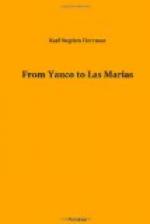Anybody will be able to understand that we were pretty hungry at the end of the second day. We were thirsty too—I paid as much as fifty cents for a glass of ice-water from the cabin—but I will skip the mass of details. We had seen the piles of neat cans, labelled “roast beef,” stacked up on the dock at Port Tampa, and we were impatient for the first mess-call that made us acquainted with the contents of those cans. I regret that I cannot adequately describe to you the appearance of the stuff. I will simply say that it looked filthy, was covered with a sort of slime, and emitted a nauseous odor. It was very hard to even gaze at it and remain unmoved, but we did more than that—we tried to eat it. I managed to swallow three mouthfuls and immediately became wretchedly sick. The example seemed to be popular.
On the succeeding day we were each given an unopened can of the meat, which was supposed to last us for twenty-four hours. Most of the men threw their portions overboard at once; a few packed away the “corpse”—as we already called it—for purposes of trade with the unsophisticated Cubans; and I kept my can as a souvenir. I did not, however, keep it long; for, chancing to drop it upon the deck, the contents exploded with a distinct report, startling me not a little and covering my person with the debris. At the time I thought this experience was going to be altogether unique, but I discovered afterward that the same thing happened in a great many other instances.
Having abandoned the beef, we were forced to subsist on hard tack and tomatoes for the rest of the voyage, and hailed with joy our anchorage at Daiquiri. But we were too previous. During our ten days’ stay in Cuba we found the “corpse” still waiting for us in the mess, and we carried the ghastly burden along when we finally steamed away for Puerto Rico.
We landed at Guanica on the 25th of July, which meant that we had been half-starved for twenty-two days. We had forgotten the “Maine” and would have greeted Weyler himself with a glad sweet smile, had he come bearing in his hands food fit for a human being. Once more disembarked, we lost sight of the canned roast beef for good—save at extremely rare intervals while on the march. We found no difficulty in eating the beef obtained from Puerto Rican steers, although it was tough and bloodless; and we received salt pork often enough to furnish variety.
After the cessation of hostilities we began to get American beef instead of the native article, and, while it was by no means so impossible a food as its canned cousin, it certainly could not be called delicious. It smelled badly before it was cooked, was rigid and stringy when served, and had a rank taste, like—well like nothing else on earth. Our sick-list doubled at this time.
IV
A list of the killed and wounded on the American side, at the battle near Hormigueros, Puerto Rico, on the 10th of August, 1898.




